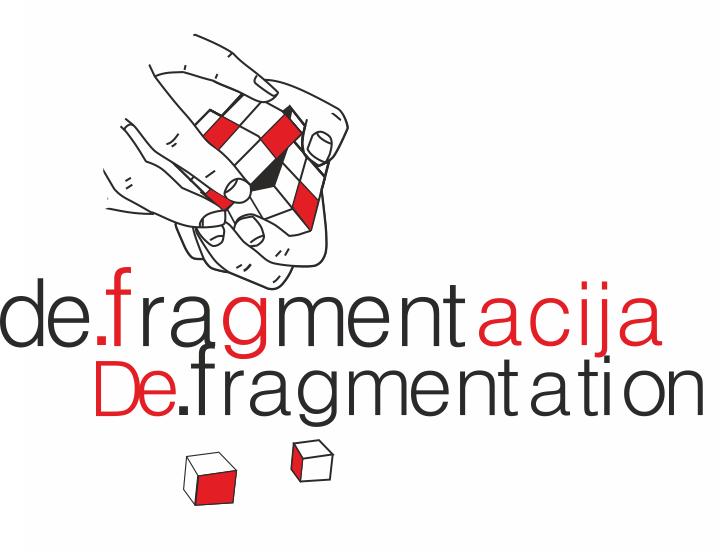

BridA was established in 1996 at the Venice Academy of Fine Arts, where its members Tom Kerševan, Sendi Mango and Jurij Pavlica were studying. Their work is based on analyzing the processes and roles within contemporary art, the principle of artistic collaboration and group work, research and projects which include collaborations with other artists, experts and creative minds. They are very active in their town, with numerous connections to research institutes and universities, guest appearances abroad, their own artist in residence program etc.
How would one define art in the making? As progress, evolution, a reflection of current events, an invention, development, a provocation? Whether we pick one or all of the above, new questions will inevitably ensue. What is current, what is progress, and how can it be defined in relation to art? We do have a word for art in the making. We call it contemporary art. However, this does not say much about the dynamic creative process, how it comes into being. It simply defines the moment in time in which it occurs. It is practically just an index, or a time-limited catalog of artistic achievements. There is something we cannot ignore, however. Contemporary art is a term that belongs to the present, and as such it relies on the past, just as its projection into the future.
We had no difficulties looking for the subject of this year’s Pixxelpoint, the difficulties began when we started looking for a suitable word or phrase to describe what we wanted to highlight. Defragmentation is a term which comes from technology. More specifically, it is related to the computer data storage system and concerns the process of rearranging data in order to speed up data retrieval. Upon reflection, this type of optimization simply means a more efficient use of the potential of such a device. Potential is not just something that is planned as part of the product design, it has a maximum, finite value. It is based on specific parameters, and determined only by existing needs and inventiveness/creativity. By rearranging data on the computer disk, thereby taking into consideration the device’s environment and record history, we create new electrical states, which mean a better device and progress in relation to the previous state. The time and space which contemporary art occupies and in which it manifests itself also has potential of its own. The artist app-lies his or her creativity to rearrange it into different abstract and material structures. It draws upon a limited space and time for the sole reason of causing change in a given and opportune moment. This change is not irrelevant because it signifies progress, as we have already established. In the context of the showcased artworks and artists, defragmentation is therefore a word which highlights the process as something which necessarily improves on the previous state, an invention, art.
The samurai cut with which artist Kensuke Koike slices into old photographs with chirurgic precision has an effect similar to a time machine. An image from the past suddenly becomes relevant in the present time. The vision leading the artist through complex research is not simply based on one’s individual experience in relation to the so-called collective, social consciousness. The eternal question of originality and invention in the full sense of the word remains unanswered. Just as in science, in art ideas and contents are taken out of that which already exists, a kind of community chest. Even as early as a century ago, Carl Gustav Jung wrote about the collective unconscious, and his idea of a kind of archetype of collective knowledge is very much pertinent today. Society’s attitude to art is like adding new information to a great encyclopedia – once we add something new, even if it is just a paragraph, a great deal of the article must be rewritten and adapted. This is why we cannot define the artistic dynamic simply through trends which constantly emerge and try to guide our perceptions about art. As Jani Osojnik argues, there is much more to a contemporary artistic MIND.OUT (IN.VENTION). Critical reflection is not just an image of the present as it relates to experience, but rather a constant assembling of fragments into a whole, and it is only when complete that we can fully experience its essence. The process of assembling the so-called whole takes place not only in the mysterious creative process involved in the artwork, but also in our perception of this creative process. This seemingly convoluted puzzle almost always holds a simple message, which we often define as a touch of genius. It is a fact that this geniality is achieved only when society as a whole fully perceives the artistic message as part of our current collective conscience, where all the fragments are exactly where they should be and the information has been communicated fully. This is every artist’s dream, but something else happens in reality. The understanding of the artistic act develops over decades or even centuries, when society becomes mature enough, and in most cases when the artwork is exhibited again, in a different context. We can illustrate this using the example of words and their meaning. Words have existed for millennia, but we see them as ubiquitous, they consist of letters, the alphabet, which is accessible to anyone, yet when someone arranges them in the right order and uses them in the right place at the right time, they can change the course of history.
This year’s Pixxelpoint focuses on the significance and importance of drawing on that which has passed, that which has already been created, that which has already been conceived. It emphasizes the ability that concepts and thoughts that have already been defined have in the artist’s environment and why, through transformation, these conditions are of significance in the creation of new works. It also speaks about the understanding and perception of the artwork, since it often includes concepts that are already known to us. It raises the issue of perception of time and space as they relate to the latest discoveries and juxtaposes them in dialog with the future. How should we understand the fact that this year the first artificial satellite has left our solar system and entered interstellar space? This is what the artists Špela Petrič, Miha Turšič and Maja Murnik are trying to tell us with their project Voyager/140 AU. Project OutPut by Marotta & Russo offer an insight about how futurologists of over twenty years ago envisioned our present-day reality. In our selection of artists we deliberately put ourselves in the role of the random observer and considered the environment from which and to which the festival has been placed.
The project Found Portraits by Anja Medved and the silent projection Guard post by Primož Bizjak examine the collective memory of the local environment. Both projects draw upon the invisible dividing line – the border, and relate to memories we all carry inside and identify with. We recognize the concept of a collective library in Christiana Rupp’s project and the project Travelling from Dublin to Berlin on a Ryanair flight with a Lidl bag by Mark Durkan and Eilis McDonald, who look for analogies in what is deeply engraved into our eyes – brands, or their marketing strategies, identified in their logotypes and colors. Irrelevant items, such as discarded tin cans, change their value the moment we begin to think about them, collect them and catalog them. The socio-cultural project of random litter by Owen F. Smith thus speaks about a different type of recycling. The projects AcDcWc by Sašo Sedlaček and Hu.M.C.C. by Maja Smrekar examine the issue of genuine needs and critically offer useful valuables such as energy and food as a result of optimizing the existing.
Some authors, such as Florian Grond, Marcin Ramocki, Igor Štromajer and Martin Romeo, create modified, automatic environments which enable the creation of new mind maps, which are created using the subjective perceptions of the viewer or listener. The same applies to Project 59, an Alternative Calendar in the context of which authors Irina Danilova, Hiram Levy and Dan Tulovsky modified the Gregorian calendar to number 59, forcing the viewer to alter their own time scheme and at the same time allow him or her to organize their personal tasks more creatively.
Uncertainty, lack of understanding and personal frustrations, combined with the seemingly unrealizable desire to establish oneself, is every artist’s nightmare. Lena Lieselotte Schuster decided to run an experiment on herself, which we recommend to any artist facing similar troubles. She filmed a video entitled Egotuning, where she indulges her own ego with all the finest artistic accolades.
The artist offers always new combinations, which we might define as nonlinear equations containing different variables. The result depends on the value the viewer ascribes to it. The artwork is thus more than a subjective exhibit, it forces us into thinking, rearranging, rethinking and reconceptualizing the existing, the same way that it was created itself. We might say that contemporary art production, and its understanding, requires constant optimization, or Defragmentation.
Pamela Barberi, Primož Bizjak, Mark Durkan & Eilis McDonald, Florian Grond, Kensuke Koike, Marotta & Russo, Anja Medved, Jani Osojnik, Project 59 (Irina Danilova, Hiram Levy, Dan Tulovsky), Marcin Ramocki, Martin Romeo, Christian Rupp, Lena Lieselotte Schuster, Sašo Sedlaček, Owen F. Smith, Maja Smrekar, Igor Štromajer, Miha Turšič, Špela Petrič, Maja Murnik, Slavko Glamočanin, Miha Tomšič, Visoka šola za umetnost Univerze v Novi Gorici ( Lavoslava Benčić, Blaž Bertoncelj, Dunja Danial, Urška Djukić, Peter Mišic, Iva Musović, Saša Mrak, Tine Posarelli, Pila Rusjan, Valérie Wolf Gang )
29. NOVEMBER
5.00pm opening of the exhibition Re-think; Re-edit; Re-use
School of Arts, University of Nova Gorica, Gorizia (I)
7.00pm opening of the Hydrogizma Nova Gorica installation
Rotunda of SNG Nova Gorica
8.00pm opening of the exhibition DE.fragmentation and official opening ceremony of Pixxelpoint 2013 Festival.
Nova Gorica City Gallery
30. NOVEMBER
8.00pm opening of the exhibition Voyager/ 140 AU, Art for deep space
La Corte dell'Arte Gallery - Spazio Alba Gurtner, Gorizia (I)
9.00pm Pixxelmusic: Unconventional projection, Allamhattar
La Corte dell'Arte Gallery - Spazio Alba Gurtner, Gorizia (I)
2. DECEMBER
9.00am Children’s art workshops with Pamela Barberi
Solkan Day Care Center
11.00am Pila Rusjan and Valerie Wolf Gang, presentation of young female artists
School of Arts, University of Nova Gorica, Gorizia (I)
1.00pm Guided tour of the exhibition Re-think; Re-edit; Re-use
School of Arts, University of Nova Gorica, Gorizia (I)
3. DECEMBER
9.00am Children’s art workshops with Pamela Barberi
Sonček Day Care Center, Vrtojba
5.00pm Jani Osojnik: Hydrogizma Nova Gorica, from art.ness into mind.ed.ness, lecture
Rotunda of SNG Nova Gorica
7.00pm No set, lecture and performance
La Corte dell'Arte Gallery - Spazio Alba Gurtner, Gorizia (I)
4. DECEMBER
6.00pm BridA, guided tour of the DE.fragmentacija exhibition
Nova Gorica City Gallery
5. DECEMBER
6.00pm Q-Will (Boston, USA): Jesse Ciarmataro (vocals, sampler, guitar)/Marco Germini (piano, keyboards), lecture and performance
La Corte dell'Arte Gallery - Spazio Alba Gurtner, Gorizia (I)
6. DECEMBER
12.00pm-8.00pm Anja Medved: Found portraits, fourth memory-donation action of Kinoatelje
former border crossing on Erjavčeva ulica, Nova Gorica
10.00pm Simone Rosso & Enrico Zaninotto (One Eyed Jack (Udine)), Color (Nano Rec/Hole City), Fake (Pixxelmusic)
Pieffe industry, Via Marega 14, Ločnik/Lucinico
Festival closing ceremony

Kulturni dom Nova Gorica
Bevkov trg 4
SI-5000 Nova Gorica
Slovenija
Curators:
BridA / Tom Kerševan, Sendi Mango, Jurij Pavlica
E-pošta: BridA
Project manager:
Pavla Jarc
Tel.: 05 33 540 11
Fax: 05 33 540 19
E-pošta: direktor@kulturnidom-ng.si
Project coordinator:
Mateja Poljšak Furlan
Tel.: 05 33 540 15
Fax: 05 33 540 19
E-pošta: mestnagalerija@kulturnidom-ng.si

